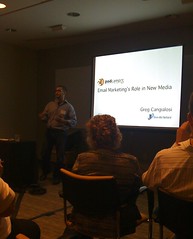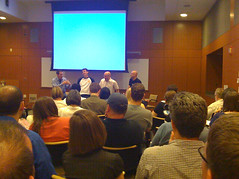Two days of social media conferencing, 340+ attendees, and a whole lot of Twittering going on.
This weekend was the third annual PodCamp Boston, a bar-camp style “un-conference” on new media and social media.
In the first session I attended, a Smart Social Media Marketing panel discussion with crayon’s Greg Verdino, SHIFT Communications’ Doug Haslam, Morpheus Media’s Adam Broitman and ooVoo’s Philip Robertson the audience agreed that “social media has not only created a need for transparency, it demands it.” They stressed that nothing is a secret anymore, and trying to keep your brand private and un-personal in the online space doesn’t give you control, it only gives you the illusion of control.
After all, people are already talking about you. The only way to gain back the supposed control that you desire is to join the conversation without being offensive and by adding value.
Christopher S. Penn, founder of PodCamp Boston chimed in with “the best way for you to engage with your audience is to let them talk about your brand.” The consensus on this topic is that you should let your audience have the opportunities to pass on or talk about your brand. Let them be the brand ambassador.
Another valuable statement that came out of this session is that we’re in a state of earned attention. In 2008, there is more to do in life than watch TV and listen to the radio. There are billions of blogs on the Internet, and if you want a valuable audience, you need to be genuine with your users. There are two voices online: generic and unique. Everyone has a unique voice, so it’s actually harder, and less effective to act like an iron wall brand.
 In a session called Email Marketing’s Role in New Media with Greg Cangialosi from Blue Sky Factory, the simple theme was the fact that “email is not dead”.
In a session called Email Marketing’s Role in New Media with Greg Cangialosi from Blue Sky Factory, the simple theme was the fact that “email is not dead”.
When Cangialosi ask the audience who checked their email that day, all 46 people in the room raised their hands. When he then asked who had checked their RSS feed today, only three hands surfaced.
Here were some points that Cangialosi also offered throughout the session.
- Email is THE dominant app
- It’s not as sexy as it once was but it’s just as profitable
- 92% of 92 percent of adult Internet users send and read email daily
- For every dollar spent on email marketing in 2007 marketer can expect a 48 percent ROI
- Email is social, transactional and marketing.
- Email is now always on hand now that mobile devices are improving and making it easy to check messages on the fly
- The one common factor in a web 2.0 world is email.
Cangialosi offered up social media maven Chris Brogan (also co-founder of PodCamp) as an example for his email newsletter. What Chris offers in his email newsletter isn’t what he offers on his blog. The two are completely different in order to offer different information on different platforms. In this way, someone interested in reading everything Brogan has to offer, needs to both read his blog and subscribe to his email newsletter.
As an email service provider, he also had some great tips on how to create great emails:
- When someone signs up for your email list, send an email right away to confirm with them what they will be getting and how often.
- Email deliverability is now based more on reputation than technical problems or trigger words. One of Cangialosi’s clients, Wine Library TV sends over 8,000 emails per day and only has a 1% spam rating due to great content thus a great spam filter reputation.
- Always put your call to action above the fold, just because it’s email doesn’t mean the same rule doesn’t apply.
- Email is one of the most highly trackable mediums you can offer your readers.
- Cross-pollinate content by tying everything you do into email.
- Email is the one place where you have a users real attention. They didn’t land on it by accident; they opened it because it was from you. Point them to other things you’ve done that might be relevant to them.
As Cangialosi said, Email is the “digital glue” of it all.
In a session called Spam in Social Media: Lessons Learned from Email with CEO/CTO of Somewhere, Inc. Kee Hinckley, the takeaway was how not to be a social media spammer.
It’s easy to be a spammer these days. The five groups that Hinckley describes as people or businesses that are likely to fall to the dark side (whether innocently or not) are:
- Borderline businesses
- Multilevel marketing professionals
- Search engine optimization professionals
- Entrepreneurial companies
What Hinckley pointed out, which I thought was a valuable theme of this discussion, was the idea that “spam is not content, it’s behavior.”
On social networks, it’s easy to blast your message out to a whole network of people that you decide is your audience. The problem with this is that spam is even less tolerated n social networks than it it anywhere else. Maintaining a positive brand image is very important on social networks because while you may have gotten 1 sale out of the whole ordeal, you might have 5,000 users who now think your brand is a spam machine. And they’ll talk about it. And you’ll hear about it.
Twitter for example, makes it very easy for people to spam. They’ve recently implemented spam bots to weed out some of the bad eggs by removing users that followed a substantial amount of users and had very few reciprocal follows.
The biggest point out of all of this is that if you are going to use social media to market your company, you need to understand the medium.
You need to take your brand apart and:
- speak with a unique voice
- be interesting
- don’t push the limits
- don’t impose yourself on anyone.
So if you’re serious about social media, start deconstructing.
One of the last sessions I attended was called Social Media Strategies, (thanks to C.C. Chapman for the photo, which I forgot to take).
The question driving this session with Chris Brogan, founder of PodCamp and Vice President of Strategy & Technology at CrossTech Media was “what’s the point of social media”? Brogan explained that if you want to integrate yourself into social media you either:
A. currently make media or
B. want to drive a new experience
For publishers, we fit into both categories. We make media, but we also want to try out new media in order to drive a new experience for our users.
Brogan used Men’s Health Managing Editor Dave Zinczenko as an example for exploring new media. When Dave created The Abs Diet, did he realize it would then get expanded into videos, podcasts and blogs?
The purpose of branching into new media is to make your content relevant to all different types of media users.
Brogan used mothers as an example. An at-home mom might not have time to sit at the computer to read your blog, but does she have time to listen to your podcast while she does the laundry or drives the kids to school? Sure. Audio is a great distribution method for busy people.
The key take-away for publishers from this session is that if you can teach things in an interesting way, more people will listen, and more people will learn.
PodCamp Boston is a great conference for anyone interested in adapting their business for social media. There are dozens of PodCamps hosted throughout the world, so if you’re interested in attending, check out PodCamp.org.
[text_ad]





